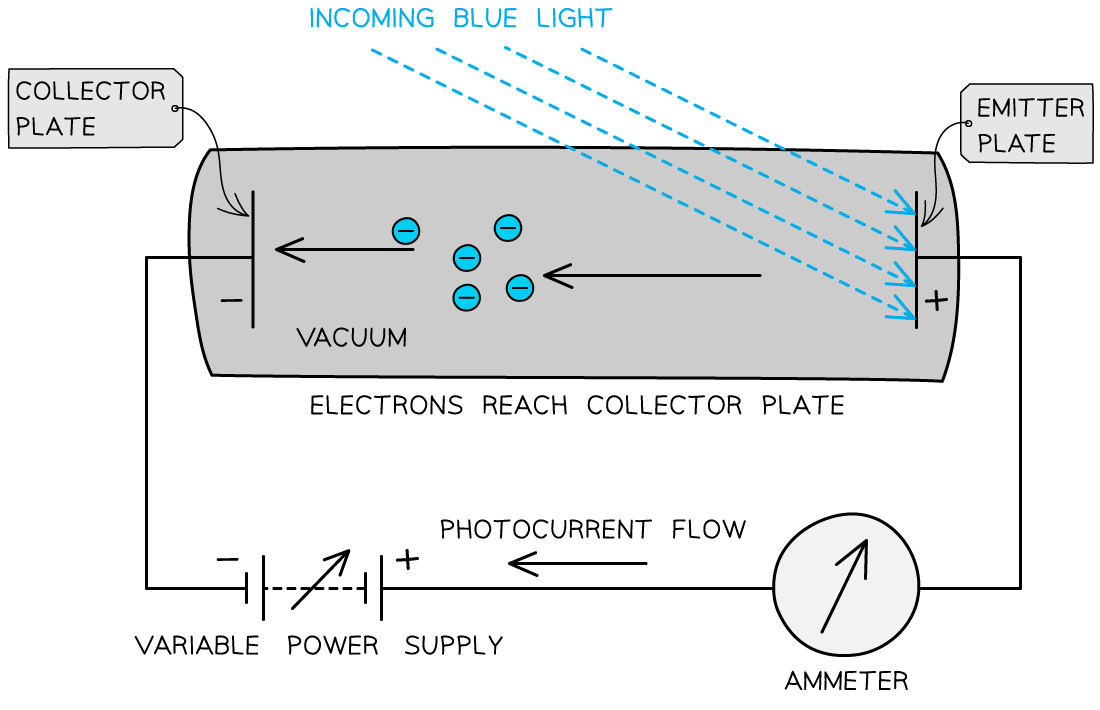The Photoelectric Equation (DP IB Physics) : Revision Note
The Photoelectric Equation
The energy of a photon is equal to:
This equation shows that:
Photon energy
and frequency
are directly proportional
Therefore, a photon which has a greater frequency than the threshold frequency of the metal will also have a greater energy than the work function of the metal
When a photon is incident on the surface of a metal, its energy is divided as follows:
The energy equal to the work function is used to liberate a photoelectron from the metal
The remaining energy will be transferred to the photoelectron as kinetic energy
This can be described using the photoelectric equation:
The maximum kinetic energy a photoelectron can have is therefore:
Where:
h = Planck's constant (J s)
f = frequency of the incident radiation (Hz)
= work function of the metal (J)
= maximum kinetic energy of a photoelectron (J)
The photoelectric equation shows that incident photons:
Which do not have enough energy to overcome the work function (Φ) will not liberate any photoelectrons
Which have a frequency equal to the threshold frequency
will be just able to liberate photoelectrons from the surface of the metal
These photons have energy equal to:
The photoelectric equation shows that for photoelectrons:
Those that are just able to escape the surface of the metal will have zero kinetic energy
The majority will have kinetic energies less than
The maximum kinetic energy
depends only on the frequency of the incident photon and not the intensity of the radiation
Graphical Representation of Work Function
The photoelectric equation can be rearranged into the equation of a straight-line:
Comparing this to the photoelectric equation:
A graph of maximum kinetic energy
against frequency
can be obtained

The key elements of the graph are:
The work function Φ is the y-intercept
The threshold frequency f0 is the x-intercept
The gradient is equal to Planck's constant h
There are no electrons emitted below the threshold frequency f0
Worked Example
The graph below shows how the maximum kinetic energy Ek of electrons emitted from the surface of sodium metal varies with the frequency f of the incident radiation.

Calculate the work function of sodium in eV.
Answer:
Step 1: Write out the photoelectric equation and rearrange it to fit the equation of a straight line
Therefore, when
,
and
Step 2: Identify the threshold frequency from the x-axis of the graph
From the graph:
When
, threshold frequency:
= 4 × 1014 Hz
Step 3: Calculate the work function
Work function: = 2.652 × 10−19 J
Step 4: Convert the work function into eV
To convert from J to eV: divide by 1.6 × 10−19 J
= 1.66 eV
Examiner Tips and Tricks
When using the photoelectric equation, hf, Φ and Ek(max) must all have the same units, so make sure your quantities are all in either eV or J.
Remember that the maximum kinetic energy part of the photoelectric equation is for a photoelectron and not a photon!
If the photoelectron is emitted with the maximum kinetic energy , it will be travelling at its maximum velocity
, which can be calculated using the kinetic energy equation:
Intensity & Photoelectric Current
Kinetic Energy & Intensity
The kinetic energy of the photoelectrons is independent of the intensity of the incident radiation
This is because each electron can only absorb one photon
Kinetic energy is only dependent on the frequency of the incident radiation
Intensity is the rate of energy transferred per unit area and is related to the number of incident photons striking the metal plate
Increasing the number of photons striking the metal plate will not increase the kinetic energy of the photoelectrons; it will increase the number of photoelectrons emitted
Why Kinetic Energy is a Maximum
Each electron in the metal acquires the same amount of energy from the photons in the incident monochromatic radiation.
However, the energy required to remove an electron from the metal varies because some electrons are on the surface whilst others are deeper in the metal
The photoelectrons with the maximum kinetic energy will be those on the surface of the metal since they do not require as much energy to leave the metal
The photoelectrons with lower kinetic energy are those deeper within the metal since some of the energy absorbed from the photon is used to approach the metal surface (and overcome the work function)
There is less kinetic energy available for these photoelectrons once they have left the metal
Photoelectric Current
The photoelectric current is a measure of the number of photoelectrons emitted per second
The value of the photoelectric current is calculated by the number of electrons emitted multiplied by the charge on one electron
Photoelectric current is proportional to the intensity of the radiation incident on the surface of the metal
This is because intensity is proportional to the number of photons striking the metal per second
Since each photoelectron absorbs a single photon, the photoelectric current must be proportional to the intensity of the incident radiation

Sketch graphs showing the trends in the variation of electron kinetic energy with the frequency and intensity of the incident light and the variation of photocurrent with the intensity of the incident light
Examiner Tips and Tricks
It is a common misconception that photoelectric current is independent of photon frequency. In an exam question, you could be asked about the effect on photoelectric current by:
Changing the intensity of the incident radiation whilst keeping the frequency constant
Changing the frequency of the incident radiation whilst keeping the intensity constant
In both scenarios, the photoelectric current will change
If you change the frequency of the incident light whilst keeping the number of photons emitted by the light source constant, then the photoelectric current will not change. This is because changing the frequency will change the energy of the emitted photons, but the number of photons will remain the same.
However, if you change the frequency of the incident light whilst keeping the intensity constant, the photoelectric current will change. This is because intensity is power per unit area which is equal to the rate of energy transfer per unit area
The energy transferred comes from the photons, where the energy of a single photon is hf
So, to account for n number of photons:
If the frequency f is increased and the intensity remains constant, then the number of photons n must decrease. Planck's constant h, and the area A of the metal plate do not change
This is because at higher frequencies, each photon has a higher energy, so fewer photons are required to maintain the same intensity.
Stopping Potential
Stopping potential
is defined as:
The potential difference required to stop photoelectron emission from occurring
The photons arriving at the metal plate cause photoelectrons to be emitted
This is called the emitter plate
The electrons that cross the gap are collected at the other metal plate
This is called the collector plate

This setup can be used to determine the maximum kinetic energy of the emitted photoelectrons
The flow of electrons across the gap sets up an e.m.f. between the plates that allows a current to flow around the rest of the circuit
Effectively, it becomes a photoelectric cell which produces a photoelectric current
If the e.m.f. of the variable power supply is initially zero, the circuit operates only on the photoelectric current
As the supply is turned up, the emitter plate becomes more positive
This is because it is connected to the positive terminal of the supply
As a result, electrons leaving the emitter plate are attracted back towards it
This is because the p.d. across the tube opposes the motion of the electrons between the plates
If any electrons escape with high enough kinetic energy, they can overcome this attraction and cross to the collector plate
And if they don't have enough energy, they can't cross the gap
By increasing the e.m.f. of the supply, eventually, a p.d. will be reached at which no electrons will be able to cross the gap
This value of e.m.f. is equal to the stopping potential
At this point, the energy needed to cross the gap is equal to the maximum kinetic energy
of the electrons
Therefore:
Where:
= maximum kinetic energy of the electrons (J)
= elementary charge (C)
= stopping voltage (V)
Intensity and Stopping Potential
Increasing the intensity of the incident radiation on the plate increases
The number of photons incident on the metal plate
The number of photoelectrons emitted from the plate, i.e. the photoelectric current
For a given potential difference, increasing the intensity increases the photoelectric current but the stopping potential remains the same
This shows that the intensity does not affect the kinetic energy of the photoelectrons
The maximum kinetic energy of the photons (and photoelectrons) depends only on
The frequency (or wavelength) of the incident photons
The work function of the metal
However, if the frequency or wavelength is changed whilst keeping the intensity constant, the photoelectric current will not be constant
For example, increasing the frequency of the incident radiation whilst keeping the intensity constant will cause the photoelectric current to decrease. This is because:
Increasing the frequency of a source means the energy of each photon increases
Keeping intensity the same means the energy transferred per unit area in a given time is constant
So, a higher frequency source must emit fewer photons per unit area in a given time than a lower frequency source (of the same intensity)
If there are fewer photons incident on a given area each second, the number of electrons emitted each second must decrease

The stopping potential remains constant even at different intensities, which shows that intensity does not affect the kinetic energy of the photoelectrons
Worked Example
Monochromatic light of wavelength is incident on the surface of a metal. The stopping potential for this light is
.
When another monochromatic light of wavelength is incident on the same surface, the stopping potential is
.
What is the quantity equal to?
A.
B.
C.
D.
Answer: C
The photoelectric equation for light 1 is
Where and
The photoelectric equation for light 2 is
Where and
Since the metal is the same, the work function
is the same for both, so:
Collecting the terms together and simplifying gives
Examiner Tips and Tricks
It is important to note that the stopping potential actually holds a negative value, but since we use it to determine the maximum kinetic energy of the emitted electrons, its sign is not important in calculations, it's acceptable to just quote its magnitude.

You've read 0 of your 5 free revision notes this week
Unlock more, it's free!
Did this page help you?
